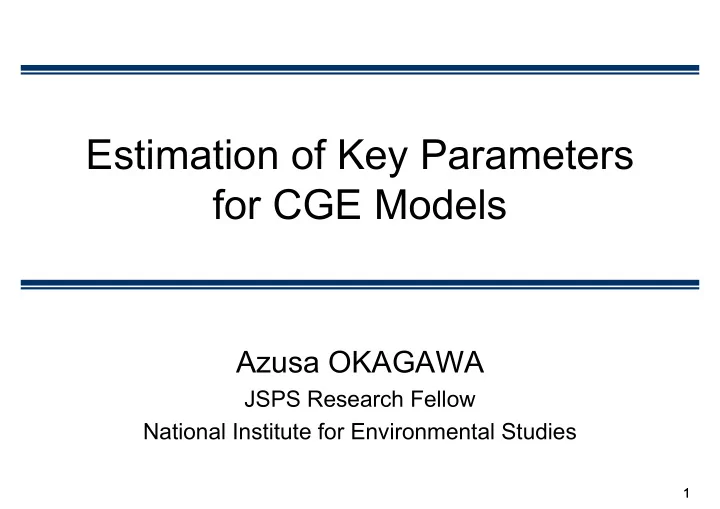

Estimation of Key Parameters for CGE Models Azusa OKAGAWA JSPS Research Fellow National Institute for Environmental Studies 1
Outline 1. Introduction 2. Estimation of substitution elasticities – What is the substitution elasticity? – Econometric model and data – Estimation results 3. Simulations with estimated parameters 4. Summary 2
Introduction • Many literatures on climate policy based on CGE modeling analysis • The simulation results and conclusions of them depend on the size of some parameters. – Substitution elasticities between production factors • The key parameters in CGE models should have empirical evidence. – Too high (low) elasticities lead to under- (over) estimates of the effects of climate policy. • The empirical foundation for the key parameters is lacking. – Based on old studies – Borrowing from famous models 3
Research problem & contribution Research problem: We need more econometric analyses which specify the key parameters of CGE models to get more reliable simulation results. We estimated nested CES production functions using a panel data for OECD countries. Contribution: Our study improves the reliability of CGE models for climate policy by estimating nested CES production functions. 4
What is the substitution elasticity? ROW Japan Import Final demand Industries Export Goods AGR MIN Household market STEEL MACH Labor … Others market Tax COAL COAL OIL OIL Capital Government market … … ELE ELE Tax Saving Investment Supply of Goods Monetary Tax Payment Compensation In most cases, we assume nested CES functions as production structures. 5
Production structure & substitution elasticities KE-L form KL-E form σ σ top top σ σ KE , L KL , E Intermediate Intermediate Inputs Inputs σ σ Labor KL KE Energy Capital Energy Labor Capital Substitution elasticity between capital (K) and Energy (E) P Q σ K E If changes by 1%, would change by %. KE P Q E K 6
Econometric model & data Firm’s cost minimization problem σ KE ⎡ ⎤ σ 1 σ 1 σ 1 KE KE - - = + + KE Q α Q ( 1 α ) Q min P Q P Q - s.t. σ σ ⎢ ⎥ KE KE E E K K E - K ⎣ ⎦ E , K CES production function The model to be estimated ⎛ ⎞ ⎛ ⎞ Q P ⎜ ⎟ ⎜ ⎟ = + + ln E β σ ln K u ⎜ ⎟ ⎜ ⎟ 0 , i KE i , t Q P ⎝ ⎠ ⎝ ⎠ K E i , t i , t Data: Panel data for 19 OECD countries with 18 industries (1970-2004), formed by the EU-KLEM project of the European Commission. 7
Estimation results KE-L KL-E Conventional Our estimation Conventional Our estimation σ top σ top Chemical 0.00 < 0.81 0.00 < 0.85 Other Non-metallic Mineral 0.00 < 0.98 0.00 < 0.31 Iron & Steel 0.00 < 1.05 0.00 < 1.17 Machinery 0.00 < 1.15 0.00 < 0.13 Electrical equipment 0.00 < 0.75 0.00 < 0.88 Transport equipment 0.00 < 1.04 0.00 < 0.55 Transport 0.00 < 1.05 0.00 < 0.35 Construction 0.00 < 0.97 0.00 < 1.26 σ KE-L σ KL-E Chemical 0.80 > 0.34 0.40 > 0.00 Other Non-metallic Mineral 0.80 > 0.21 0.40 < 0.41 Iron & Steel 0.80 > 0.00 0.40 < 0.64 Machinery 0.80 > 0.08 0.40 > 0.29 Electrical equipment 0.80 > 0.33 0.40 < 0.52 Transport equipment 0.80 > 0.43 0.40 < 0.52 Transport 0.80 > 0.47 0.40 > 0.28 Construction 0.80 < 0.94 0.40 < 0.53 σ KE σ KL Chemical 0.10 > 0.04 1.00 > 0.33 Other Non-metallic Mineral 0.10 < 0.35 1.00 > 0.36 Iron & Steel 0.10 < 0.29 1.00 > 0.22 Machinery 0.20 > 0.12 1.00 > 0.30 Electrical equipment 0.20 < 0.25 1.00 > 0.16 Transport equipment 0.20 > 0.09 1.00 > 0.14 Transport 0.10 < 0.45 1.00 > 0.31 Construction 0.20 > 0.11 1.00 > 0.07 8
Simulations by 4 models • 4 CGE models 1. KE-L model with conventional parameters 2. KE-L model with new parameters 3. KL-E model with conventional parameters 4. KL-E model with new parameters The goal of simulations: CO 2 reduction by 13% to meet the Kyoto Target 9
Comparison of simulation results GDP Equivalent Value Carbon tax rate Model (%) (%) (yen/t-C) KE-L -1.10 -0.19 18,766 KE-L with new prms -0.79 -0.16 13,160 KL-E -0.76 -0.16 12,305 KL-E with new prms -0.73 -0.15 12,001 We could over-estimate necessary carbon tax rate by 43% more if we use conventional values of key parameters for the KE-L models. 10
Industrial output (%) Electrical Transport Mining Chemical Iron & Steel Machinery equipment equipment Transport Construction 2 1 0 -1 U A B m o r f -2 e g n a h c -3 % -4 -5 -6 KE-L KE-L with new prms KL-E KL-E with new prms 11 11
CO 2 emissions (%) Electrical Transport Mining Chemical Iron & Steel Machinery equipment equipment Transport Construction 0 -5 -10 U A B m o r f -15 e g n a h c % -20 -25 -30 KE-L KE-L with new prms KL-E KL-E with new prms 12
Summary • We specified key parameters of CGE models by the econometric analysis. – Higher elasticities for energy intensive industries – Lower elasticities for non-energy intensive industries • If we use conventional parameters, we could over-estimate the impacts of the climate policy. – 43% higher reduction costs for 1t of CO 2 emissions – Distribution of reduction costs of CO 2 emissions between industries 13 13
Thank you! Comments are welcome. okagawa.azusa@nies.go.jp 14 14
Recommend
More recommend